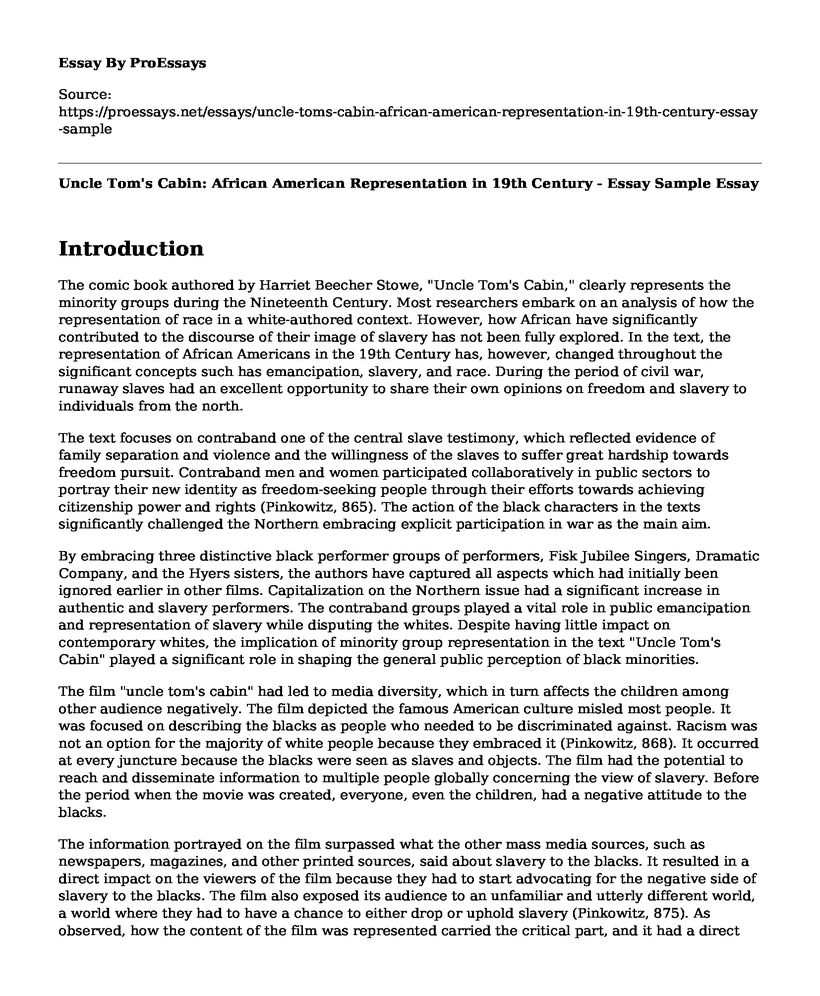Introduction
The comic book authored by Harriet Beecher Stowe, "Uncle Tom's Cabin," clearly represents the minority groups during the Nineteenth Century. Most researchers embark on an analysis of how the representation of race in a white-authored context. However, how African have significantly contributed to the discourse of their image of slavery has not been fully explored. In the text, the representation of African Americans in the 19th Century has, however, changed throughout the significant concepts such has emancipation, slavery, and race. During the period of civil war, runaway slaves had an excellent opportunity to share their own opinions on freedom and slavery to individuals from the north.
The text focuses on contraband one of the central slave testimony, which reflected evidence of family separation and violence and the willingness of the slaves to suffer great hardship towards freedom pursuit. Contraband men and women participated collaboratively in public sectors to portray their new identity as freedom-seeking people through their efforts towards achieving citizenship power and rights (Pinkowitz, 865). The action of the black characters in the texts significantly challenged the Northern embracing explicit participation in war as the main aim.
By embracing three distinctive black performer groups of performers, Fisk Jubilee Singers, Dramatic Company, and the Hyers sisters, the authors have captured all aspects which had initially been ignored earlier in other films. Capitalization on the Northern issue had a significant increase in authentic and slavery performers. The contraband groups played a vital role in public emancipation and representation of slavery while disputing the whites. Despite having little impact on contemporary whites, the implication of minority group representation in the text "Uncle Tom's Cabin" played a significant role in shaping the general public perception of black minorities.
The film "uncle tom's cabin" had led to media diversity, which in turn affects the children among other audience negatively. The film depicted the famous American culture misled most people. It was focused on describing the blacks as people who needed to be discriminated against. Racism was not an option for the majority of white people because they embraced it (Pinkowitz, 868). It occurred at every juncture because the blacks were seen as slaves and objects. The film had the potential to reach and disseminate information to multiple people globally concerning the view of slavery. Before the period when the movie was created, everyone, even the children, had a negative attitude to the blacks.
The information portrayed on the film surpassed what the other mass media sources, such as newspapers, magazines, and other printed sources, said about slavery to the blacks. It resulted in a direct impact on the viewers of the film because they had to start advocating for the negative side of slavery to the blacks. The film also exposed its audience to an unfamiliar and utterly different world, a world where they had to have a chance to either drop or uphold slavery (Pinkowitz, 875). As observed, how the content of the film was represented carried the critical part, and it had a direct influence on the thoughts and to what others believed.
The ones who were affected more by the message of the film were the children. They became confused because they had no frame of reference on what aspect or on which side to take. Children absorb the content that they see onscreen, and their attitudes are dependent on the films they watch. It is clear that Media diversity made children among other audiences to view slavery, and the blacks oppositely to what their others wanted and believed in.
Work Cited
Pinkowitz, Jacqueline. "Revising Slavery, Reissuing Uncle Tom's Cabin: Interracial Sex and Black Resistance in the Black Power Era Slavery Exploitation Film Cycle." The Journal of Popular Culture 52.4 (2019): 862-889. https://www.academia.edu/download/61051865/Pinkowitz_RevisingSlavery20191028-64638-1skz5jc.pdf
Cite this page
Uncle Tom's Cabin: African American Representation in 19th Century - Essay Sample. (2023, Aug 01). Retrieved from https://proessays.net/essays/uncle-toms-cabin-african-american-representation-in-19th-century-essay-sample
If you are the original author of this essay and no longer wish to have it published on the ProEssays website, please click below to request its removal:
- Harlem Renaissance Poetry Themes - A Literary Essay Sample
- The Moral Justification Against and in Favor of Torture in 1984
- Invictus by John Carlin Essay Example
- Poetry Analysis Essay on The Love Song J. Alfred Prufrock
- Macbeth: Use of Dramatic Irony Essay Example
- Essay Example on Top Girls & A Raisin in the Sun: Women's Place in Society
- Book Review Sample on The Tale-Tell Heart







